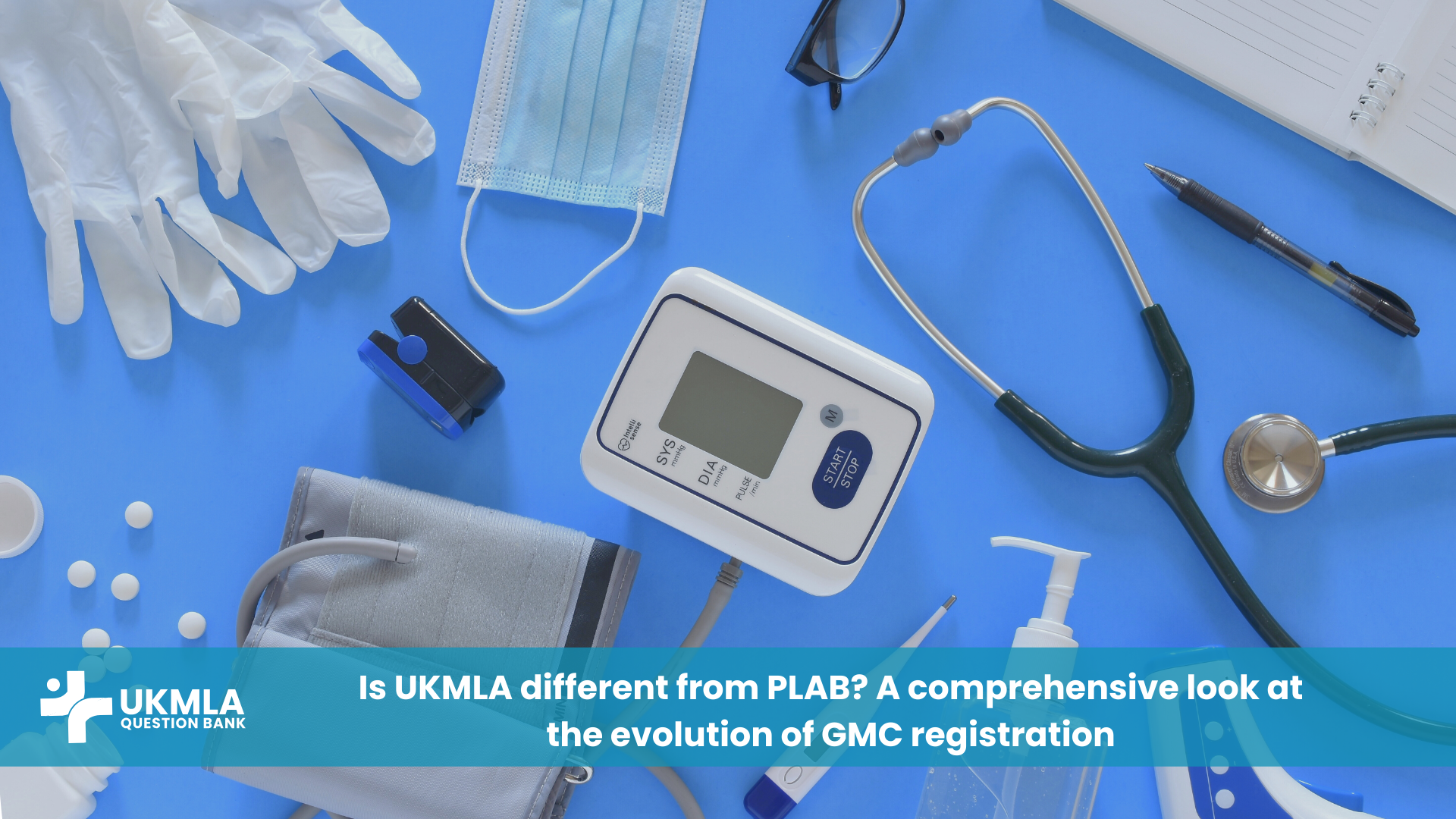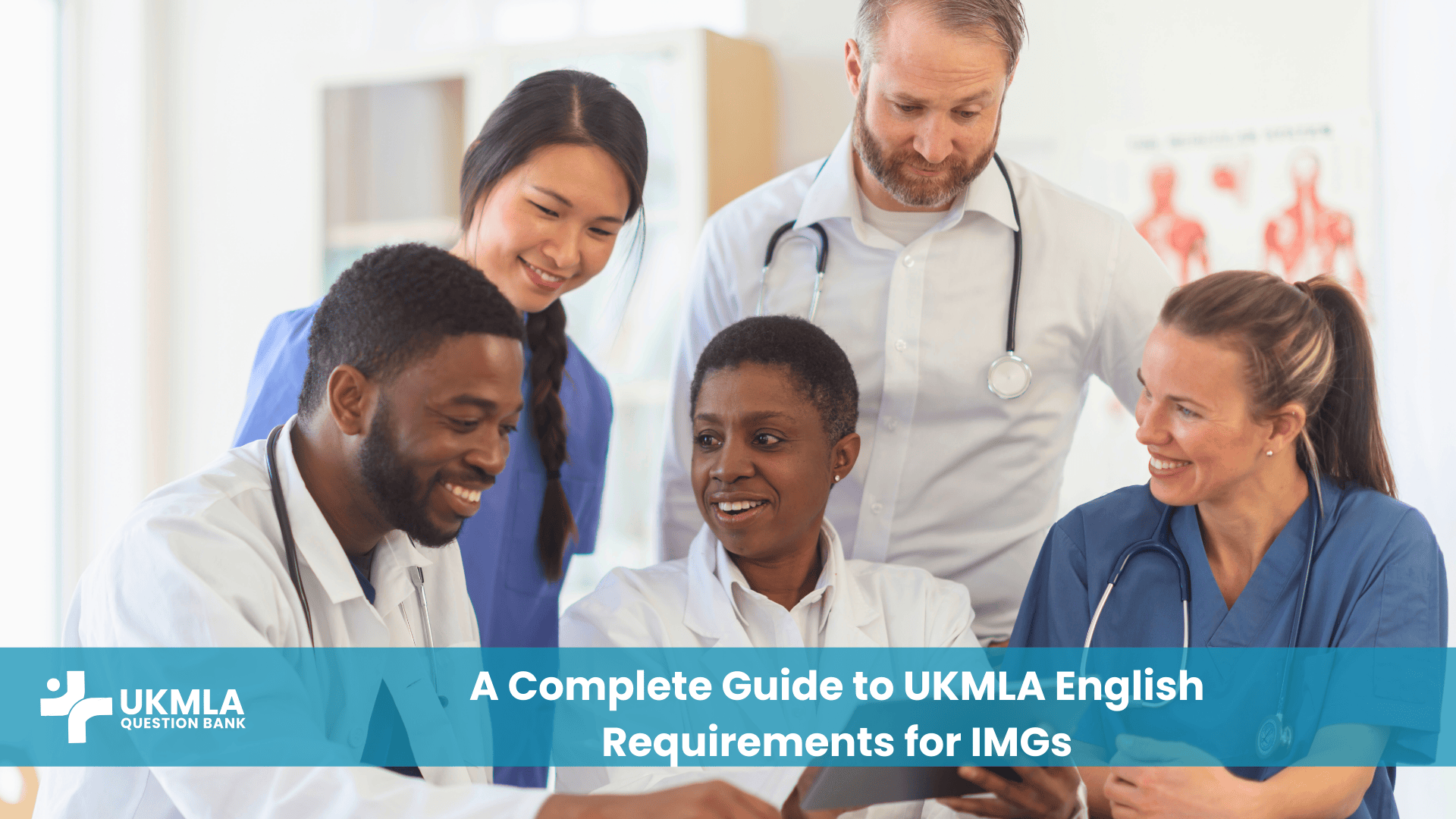The landscape of General Medical Council (GMC) registration in the United Kingdom is undergoing a significant transformation. This change brings the UKMLA vs PLAB comparison sharply into focus for all aspiring medical professionals. Understanding the intricate details of this UKMLA vs PLAB distinction is now more critical than ever for anyone navigating these medical licensing pathways.
For many years, the Professional and Linguistic Assessments Board (PLAB) test served as the primary gateway for International Medical Graduates (IMGs) seeking to practice in the UK. However, the introduction of the UK Medical Licensing Assessment (UKMLA) is fundamentally reshaping this pathway. This makes a thorough analysis of the UKMLA vs PLAB differences essential for all candidates.
This blog post delves deep into the UKMLA vs PLAB debate. It meticulously explores the specific differences, the implications of this UKMLA vs PLAB transition for various groups of doctors, and how to effectively navigate this new era of GMC registration. We will maintain a keen eye on the UKMLA vs PLAB requirements throughout. The shift from PLAB to UKMLA represents more than just a name change; it’s a paradigm shift, and a clear understanding of UKMLA vs PLAB specifics will be indispensable. The core of this discussion revolves around this key UKMLA vs PLAB comparison.
Understanding PLAB: The Predecessor in the UKMLA vs PLAB Timeline
Before we can fully appreciate the nuances of the current UKMLA system and the full scope of the UKMLA vs PLAB changes, it’s crucial to understand the assessment it is substantially revising: the PLAB test. The PLAB test was designed by the GMC with the specific aim of ensuring that IMGs possessed the necessary knowledge and skills to practise medicine safely within the UK healthcare system. This assessment was a critical hurdle for overseas doctors, and its characteristics form an important part of the historical context for the UKMLA vs PLAB discussion.
The PLAB examination itself was a two-part assessment, a structure that has echoes in the current UKMLA vs PLAB framework:
PLAB Part 1: This was a multiple-choice question (MCQ) examination. Its primary purpose was to test the application of medical knowledge to patient care scenarios. The content typically covered common, important, or acute conditions that a trainee might encounter when entering the second year of the Foundation Programme (F2). Furthermore, PLAB Part 1 also incorporated aspects of medical ethics and an understanding of the UK healthcare system, elements that continue to be relevant when evaluating UKMLA vs PLAB.
PLAB Part 2: This component was an Objective Structured Clinical Examination (OSCE). It consisted of several clinical stations designed to simulate real-life medical scenarios. PLAB Part 2 assessed a candidate’s clinical skills, their communication abilities (both with patients and colleagues), and their overall professionalism. Scenarios often included history taking, physical examination, performing practical procedures, and managing patient interactions effectively. These skillsets remain vital when considering preparation for current assessments within the UKMLA vs PLAB spectrum.
It’s important to note, especially when drawing a UKMLA vs PLAB comparison, that the primary audience for the PLAB test was strictly IMGs. UK medical graduates, upon successful completion of their medical degree from a UK university, qualified for provisional GMC registration without the requirement to sit the PLAB test. This difference in pathways is a key historical point in the UKMLA vs PLAB narrative.
While PLAB served its purpose effectively for many decades, the GMC eventually identified a pressing need for a more unified and consistent standard for all doctors entering UK practice. This need directly led to the development of the UKMLA, marking a significant juncture in the UKMLA vs PLAB evolution.
The limitations of the PLAB-only system for IMGs, or perhaps more accurately, the areas ripe for evolution that further clarify the necessity of the UKMLA vs PLAB shift, included the fundamental fact that UK graduates and IMGs were assessed through entirely different final hurdles before achieving full GMC registration. This disparity meant there wasn’t a common threshold for all doctors embarking on their careers in the UK.
Addressing this inconsistency to enhance patient safety and public confidence became a key objective for the GMC, ultimately shaping the transition to the UKMLA. The move towards a single standard is a defining characteristic of this evolution. Understanding this historical context is vital for a complete perspective on the UKMLA vs PLAB changes.
The Dawn of a New Era: Introducing the UKMLA – The Modern Assessment in the UKMLA vs PLAB Discussion
The General Medical Council announced the UK Medical Licensing Assessment (UKMLA) as a new, unified assessment. It is designed for all doctors wishing to practise medicine in the United Kingdom. This applies regardless of whether they graduated from a UK medical school or are an International Medical Graduate, a pivotal point in the UKMLA vs PLAB framework.
This unification is perhaps the single most significant factor when analyzing the UKMLA vs PLAB differences. The primary rationale behind the introduction of the UKMLA is to establish a common and consistent threshold for safe medical practice for every doctor joining the UK medical register, a core goal of this UKMLA vs PLAB initiative.
The GMC’s stated objectives for introducing the UKMLA Exam include several key points that underscore the significance of this UKMLA vs PLAB change:
Standardisation: A primary goal of this change is to ensure that every doctor granted a licence to practise in the UK has met the same high standard. This offers greater assurance to patients, employers, and the wider public regarding the competence of newly qualified doctors, aiming to eliminate previous disparities. The UKMLA vs PLAB comparison highlights this move towards uniformity.
Fairness: By creating a single assessment framework, the new system aims to establish a more level playing field for all new entrants to the medical register, irrespective of their place of primary medical qualification. This fairness is a cornerstone of the UKMLA vs PLAB philosophy.
Modernisation: The UKMLA is designed to reflect contemporary medical practice. It encompasses the latest knowledge, skills, and professional behaviours required for newly qualified doctors in the demanding UK healthcare environment. This modern approach is a hallmark of the recent evolution in medical assessment, clearly demonstrated in the UKMLA vs PLAB model.
Patient Safety: Ultimately, this initiative reinforces the GMC’s unwavering commitment to patient safety. It ensures that all doctors entering UK practice demonstrate the necessary competence against a common set of outcomes before they are entrusted with patient care. This commitment is central to the entire UKMLA vs PLAB reform.
Who needs to take the UKMLA Exam under the new UKMLA vs PLAB system?
This is one of the most significant shifts when comparing the new assessment with the old PLAB system. The UKMLA will be a mandatory requirement for:
UK Medical Students: Students graduating from UK universities in the academic year 2024-2025 onwards will need to pass the UKMLA as an integral part of their medical degree. Successful completion will be necessary before they can be granted provisional registration with a licence to practise. This integrates the national standard directly into UK medical education, a key aspect of the current UKMLA vs PLAB landscape.
International Medical Graduates (IMGs): IMGs who previously would have undertaken the PLAB test will now need to pass the UKMLA to gain GMC registration. The transition for IMGs has been carefully phased, with PLAB exams becoming UKMLA-compliant. For instance, PLAB 1 exams from August 2024 and PLAB 2 exams from May 2024 are based on the new MLA content map, effectively aligning the old pathway with the new UKMLA vs PLAB standards. The UKMLA vs PLAB transition is thus comprehensive.
The rollout of the UKMLA is being meticulously managed. UK medical schools are actively integrating the UKMLA into their final examinations. IMGs are transitioning from the PLAB system to these UKMLA-compliant assessments. This careful management is crucial for the success of this UKMLA vs PLAB initiative.
UKMLA vs PLAB: A Head-to-Head Comparison of Assessment Frameworks
While the GMC has indicated that the introduction of the UKMLA for IMGs (who would have previously taken PLAB) will see many similarities in the format and style of the examinations, crucial differences and evolutionary aspects must be considered. This is vital when conducting a detailed UKMLA vs PLAB comparison. This UKMLA vs PLAB distinction isn’t just superficial; it reflects a deeper change in assessment philosophy and is a key area for candidates to understand.
1. Scope and Applicability: The Biggest Shift in the UKMLA vs PLAB Dynamic
PLAB: This examination was exclusively for International Medical Graduates (IMGs). The scope of PLAB is a historical point in the UKMLA vs PLAB discussion.
UKMLA: This assessment is for all doctors applying for provisional registration – encompassing both UK graduates and IMGs. This unification is the absolute cornerstone of the UKMLA and the most striking point in any analysis of the UKMLA vs PLAB differences. This inclusivity defines the modern UKMLA vs PLAB approach.
This fundamental change means that, for the first time, there will be a national licensing examination that all doctors must pass to practise in the UK. This applies irrespective of their country of primary medical qualification. This universal application is what truly sets the new model apart from the old within the UKMLA vs PLAB context.
2. Exam Structure and Content: Evolution in the UKMLA vs PLAB Model
The UKMLA Exam maintains a two-part structure, which will feel familiar to those acquainted with the PLAB system. However, it operates under a new guiding framework – the MLA Content Map. Understanding this map is key to understanding the differences between the UKMLA and PLAB, and thus central to the UKMLA vs PLAB comparison.
Applied Knowledge Test (AKT): This is the first part of the UKMLA.
Similarities to PLAB 1 (in the UKMLA vs PLAB context): The UKMLA AKT is a computer-based MCQ exam. It is designed to test the candidate’s ability to apply medical knowledge in practical clinical scenarios. The questions will be in a single-best-answer (SBA) format. These structural similarities are important when evaluating UKMLA vs PLAB.
Differences/Evolution: The AKT is meticulously based on the new MLA Content Map. This map is significantly more comprehensive and explicitly details the core knowledge, skills, and professional behaviours expected of a doctor ready for UK practice. While PLAB 1 was based on its own blueprint, the MLA Content Map aims for broader and deeper coverage. This potentially includes a greater emphasis on critical areas such as professionalism, medical ethics, patient safety protocols, the ability to manage uncertainty effectively, and UK-specific healthcare system knowledge. This depth is a key UKMLA vs PLAB differentiator.
The themes underpinning the MLA Content Map are: readiness for safe practice, managing uncertainty, and delivering person-centred care. The domains are extensive. They cover areas of clinical practice, professional knowledge, clinical and professional capabilities, practical skills and procedures, common patient presentations, and a wide array of conditions. Understanding these domains is vital for anyone tackling this new challenge presented by the UKMLA vs PLAB system.
Clinical and Professional Skills Assessment (CPSA): This is the second part of the UKMLA.
Similarities to PLAB 2 (in the UKMLA vs PLAB context): The UKMLA CPSA is an OSCE-style examination. It is designed to assess a candidate’s clinical skills, communication abilities, and professionalism through a series of simulated patient encounters. For IMGs, the CPSA will continue to be held at the GMC’s dedicated clinical assessment centre in Manchester. The OSCE format remains a constant in the UKMLA vs PLAB clinical assessment.
Differences/Evolution: Like the AKT, the CPSA is also rigorously aligned with the MLA Content Map. This means that the scenarios encountered and the criteria for assessment will directly reflect the broader themes and detailed domains of the map. Candidates might experience an enhanced focus on integrated clinical skills, complex decision-making, ethical considerations as they arise in practice, and the nuances of communication specific to the UK healthcare environment. While PLAB 2 was undoubtedly a rigorous examination, the CPSA, guided by the unified MLA standard, will ensure these essential competencies are assessed consistently and robustly for all candidates. This transition aims for a higher degree of standardization in the UKMLA vs PLAB practical exam.
3. Standard Setting and Perceived Difficulty in the UKMLA vs PLAB Context
The GMC has clearly stated that the UKMLA is not designed to be inherently “harder” than the PLAB test. Instead, its primary intention is to create a common threshold for all doctors. This principle is central to the UKMLA vs PLAB change.
However, the increased emphasis on a broader range of competencies outlined in the comprehensive MLA Content Map could be a factor. The very act of standardising assessments across both UK and international graduates could also mean that certain aspects of the new assessments feel more challenging or require a different, more focused preparatory approach. The debate on UKMLA vs PLAB difficulty often revolves around these points.
Common Pass Mark: A key feature of the UKMLA system is that it will have a common pass standard applied to all candidates, whether they are UK graduates or IMGs. This unified standard is a defining element of the UKMLA vs PLAB reform.
Initial Adaptation: As with any newly introduced large-scale assessment, there might be an initial adaptation period for both candidates and educators. Some early anecdotal reports from pilot runs of UKMLA-style questions have suggested that they might be more nuanced. These questions may require deeper clinical reasoning and a very firm grasp of NHS guidelines and ethical frameworks. This nuanced approach in the UKMLA could be a factor when discussing UKMLA vs PLAB challenges. It is anticipated by some in the medical education field that initial pass rates for the UKMLA might be lower as candidates adjust to the potentially higher and more rigorously assessed standards.
4. Focus on “UK Practice” within the UKMLA vs PLAB Framework
While the PLAB test already aimed to ensure that IMGs were fit for UK practice, the UKMLA places an even stronger and more explicit emphasis on this. It achieves this through its comprehensive content map, developed with extensive input from across the UK medical education system. This enhanced focus is a critical element when comparing UKMLA vs PLAB and understanding the overall UKMLA vs PLAB philosophy.
This includes a thorough understanding of NHS structures, patient pathways, common ethical dilemmas encountered in the UK, and a deep, practical understanding of the GMC’s Good Medical Practice guidelines. The UKMLA will likely probe these areas more deeply, making the UKMLA vs PLAB preparation for this aspect critical.
Key Differences Summarized: UKMLA vs PLAB At-a-Glance
To clearly delineate the UKMLA vs PLAB distinctions, the following table summarizes the main differences:
Feature | PLAB (The Predecessor) | UKMLA (The Current Standard in the UKMLA vs PLAB Era) |
Primary Audience | International Medical Graduates (IMGs) only | All new doctors (UK graduates and IMGs) |
Guiding Document | PLAB Blueprint | MLA Content Map (more comprehensive, three themes, six domains) |
Written Exam | PLAB Part 1 (MCQ) | Applied Knowledge Test (AKT) (MCQ, based on MLA Content Map) |
Clinical Exam | PLAB Part 2 (OSCE) | Clinical and Professional Skills Assessment (CPSA) (OSCE, also based on the MLA Content Map |
Standardisation | Standard specifically for IMGs | Common threshold for all doctors entering UK practice – the core of the UKMLA vs PLAB philosophy. |
Focus | Core clinical knowledge and skills | Broader emphasis on ethics, professionalism, patient safety, UK-specific guidelines, managing uncertainty, and person-centred care, all crucial in the UKMLA vs PLAB context. |
Implementation | Long-standing exam for IMGs | Phased rollout from 2024; PLAB aligning to UKMLA standards for IMGs; UK grads from 2024-25 academic year |
Understanding this table is crucial for anyone navigating the UKMLA vs PLAB requirements.
The Impact of the UKMLA: Reshaping Medical Licensing Post-PLAB
The introduction of the UKMLA Exam has significant and far-reaching implications. These affect various stakeholders involved in medical education and practice in the UK. The consequences of this shift from the PLAB era to the current UKMLA vs PLAB landscape are multifaceted.
On UK Medical Students
This represents a major change in their educational journey when considering the UKMLA vs PLAB context. UK medical students will now need to pass the UKMLA as part of their university medical degree. This is necessary to be eligible for provisional GMC registration.
This effectively standardises final assessments across all UK medical schools. It ensures a consistent benchmark for graduation and subsequent entry into the Foundation Programme. Medical schools across the UK are diligently aligning their curricula and assessment methods with the MLA Content Map to prepare students for this new UKMLA vs PLAB reality.
On International Medical Graduates (IMGs)
For IMGs, this UKMLA vs PLAB transition essentially brings the pathway they previously knew as PLAB into alignment with the new national standard. While the format of the two parts of the UKMLA (the AKT and the CPSA) will feel structurally familiar to those who prepared for PLAB Part 1 and Part 2, the crucial difference lies in the content emphasis. This emphasis is now guided by the comprehensive MLA Content Map.
The UKMLA vs PLAB distinction for IMGs is therefore less about a radical structural overhaul. It’s more about the refined focus, the broader scope of assessed competencies, and the significant fact that they are being assessed against the exact same standard as UK graduates. Many perceive this UKMLA vs PLAB change as leading to a more transparent and equitable system.
On Medical Education in the UK
The advent of the UKMLA, and the detailed MLA Content Map that underpins its assessments, is prompting medical schools to embed these national standards deeply into their curricula. This ensures that students are prepared not just for their internal university exams but specifically for the competencies required by the UKMLA.
This national approach, a direct result of the new assessment initiative, might lead to more harmonised medical education outcomes across the entire United Kingdom, a significant outcome of the UKMLA vs PLAB reforms.
Preparing for the UKMLA Exam: The Essential Role of a UKMLA Question Bank in the UKMLA vs PLAB Context
Thorough and strategic preparation has always been the key to success in high-stakes medical examinations. The UKMLA Exam is certainly no exception. Given the detailed and comprehensive nature of the MLA Content Map, which dictates the content for the UKMLA vs PLAB assessments, and the integrated style of assessment, a well-thought-out approach to studying is absolutely crucial.
This is precisely where a high-quality UKMLA Question Bank becomes an indispensable tool for anyone facing the UKMLA vs PLAB challenge. Understanding the UKMLA vs PLAB differences can also guide effective preparation strategies.
Why is a UKMLA Question Bank so important for navigating the UKMLA vs PLAB assessments?
Familiarity with Question Style (UKMLA vs PLAB specific): The AKT component of the UKMLA comprises MCQs. Practising with a vast bank of questions meticulously designed in the style of the UKMLA Exam helps candidates become intimately familiar with the question format. It also helps with understanding the way clinical scenarios are presented, and the type of critical clinical reasoning required to succeed in the UKMLA vs PLAB written paper.
Comprehensive Coverage of the MLA Content Map (Essential for UKMLA vs PLAB): A good UKMLA Question Bank will be meticulously mapped to the MLA Content Map. This mapping ensures that your revision comprehensively covers all the necessary domains, overarching themes, common patient presentations, and specific conditions outlined by the GMC for the UKMLA vs PLAB assessments. It also helps in identifying areas of strength and weakness across the broad curriculum when preparing for the UKMLA vs PLAB exams.
Application of Knowledge (A Core Tenet of UKMLA vs PLAB): The UKMLA, much like its PLAB predecessor but with potentially more nuance, is not just about the recall of isolated facts. It’s fundamentally about applying medical knowledge to realistic clinical scenarios. A robust UKMLA Question Bank provides countless opportunities to practice this application. This thereby hones diagnostic skills, management planning abilities, and ethical decision-making within the UKMLA vs PLAB framework.
Understanding UK-Specific Guidelines (Crucial for UKMLA vs PLAB): The UKMLA places a significant emphasis on readiness for UK practice. Question banks specifically tailored for the UKMLA will incorporate scenarios that reflect NHS protocols, current NICE guidelines, and common ethical considerations prevalent in the UK healthcare system. This is a critical area where the distinction between generic medical knowledge and UK-contextualised knowledge, so important for the UKMLA vs PLAB exams, becomes clear.
Timed Practice and Exam Simulation (Simulating the UKMLA vs PLAB Experience): Many leading UKMLA Question Banks offer the facility to undertake timed mock exams. This feature helps candidates practice essential time management skills, a crucial factor for success in the AKT component of the UKMLA vs PLAB assessment. It also simulates the pressure and conditions of the actual UKMLA Exam environment.
Detailed Explanations (Learning from every UKMLA vs PLAB style question): The best question banks don’t just provide the correct answers. They offer detailed, clear explanations for both the correct and incorrect options. This pedagogical approach turns every practice question into a valuable learning opportunity. It helps to solidify understanding of UKMLA vs PLAB concepts and clarify any misconceptions.
Performance Tracking (Monitoring Progress for UKMLA vs PLAB): Modern UKMLA Question Banks often include sophisticated performance analytics. These tools allow candidates to track their progress over time, identify areas where they are persistently weak, and consequently focus their study efforts more effectively for the UKMLA vs PLAB examinations.
Choosing and Using a UKMLA Question Bank Effectively for the UKMLA vs PLAB Journey
Quality and Relevance to UKMLA vs PLAB: Ensure the question bank is specifically designed for the UKMLA and accurately reflects the latest iteration of the MLA Content Map. Look for resources developed by experienced medical educators who are deeply familiar with UK medical standards and the nuances of the UKMLA vs PLAB assessments.
Volume and Variety of Questions: A large number of questions covering a wide range of topics from the MLA Content Map is highly beneficial for comprehensive UKMLA vs PLAB preparation.
Start Early with your UKMLA vs PLAB Preparation: Integrate the UKMLA Question Bank into your study plan from an early stage. Do not leave question practice for last-minute cramming before the UKMLA Exam.
Active Learning, Not Passive Answering: Don’t just passively answer questions. Actively engage with the explanations provided, make concise notes, and refer back to your core study materials for topics you find particularly challenging within the UKMLA vs PLAB curriculum.
Mix with Other Resources for Holistic UKMLA vs PLAB Prep: While a UKMLA Question Bank is a vital component, it should be part of a broader, more holistic study strategy. This strategy should also include standard medical textbooks, current clinical guidelines (especially NICE and GMC’s Good Medical Practice), and, particularly for the CPSA part of the UKMLA vs PLAB assessment, dedicated practical skills practice.
The transition from PLAB to UKMLA means that all preparation resources, especially question banks, must be meticulously aligned with the new MLA Content Map to be truly effective for the UKMLA Exam. Understanding the UKMLA vs PLAB differences will guide your choice of resources.
Frequently Asked Questions (FAQs) about the UKMLA and the UKMLA vs PLAB Transition
The most significant difference in the UKMLA vs PLAB setup is that the UKMLA is a unified assessment for all doctors (both UK graduates and IMGs) seeking GMC registration. In contrast, PLAB was exclusively for IMGs. The UKMLA aims to set a common threshold for safe practice for everyone, a defining principle of the UKMLA vs PLAB shift.
For IMGs, the two-part structure of the UKMLA (AKT and CPSA) will be similar to PLAB Part 1 and Part 2. The PLAB exams are being made UKMLA-compliant, meaning they will align with the new MLA Content Map. So, while the format will feel familiar, the guiding content and standards are updated as part of the UKMLA vs PLAB evolution. The core UKMLA vs PLAB assessment philosophy emphasizes this alignment.
Yes. Students graduating from UK medical schools from the academic year 2024-2025 onwards will need to pass the UKMLA as part of their degree to gain provisional GMC registration. This is a direct consequence of the UKMLA vs PLAB standardization.
The GMC states the UKMLA isn’t designed to be “harder” but to establish a common standard. However, the MLA Content Map is comprehensive, with a strong emphasis on areas like professionalism, ethics, and UK-specific practices. Some candidates might find these aspects, or the unified standard itself within the UKMLA vs PLAB framework, more demanding. Preparation for the UKMLA Exam must be comprehensive.
The MLA Content Map is a detailed document from the GMC that outlines the core knowledge, skills, and behaviours that can be assessed in the UKMLA Exam. It is the blueprint for both the AKT and CPSA components of the UKMLA vs PLAB assessment. It covers themes like readiness for safe practice, managing uncertainty, and delivering person-centred care, across various domains of medical practice.
The GMC has provided transitional arrangements for the UKMLA vs PLAB shift. Generally, if your PLAB 1 pass is valid and was (or will be) taken when it is aligned with the MLA Content Map, it will count towards the AKT component of the UKMLA. You would then proceed to the CPSA (equivalent to PLAB 2). Always check the latest GMC guidance for specifics on the UKMLA vs PLAB transitional rules.
A good UKMLA Question Bank helps you familiarize yourself with the AKT question style. It ensures comprehensive coverage of the MLA Content Map (vital for UKMLA vs PLAB). It also allows practice in applying knowledge to UK-specific scenarios, and often provides timed mock exams and detailed explanations for effective learning for the UKMLA Exam.
The UKMLA consists of two parts. This structure is familiar from the PLAB system but now applied universally under the UKMLA vs PLAB model:
The Applied Knowledge Test (AKT): A multiple-choice question exam.
The Clinical and Professional Skills Assessment (CPSA): An Objective Structured Clinical Examination (OSCE).
The UKMLA vs PLAB transition is phased. PLAB 1 exams taken on or after August 8, 2024, and PLAB 2 exams taken on or after May 17, 2024, are based on the MLA content map. This makes them UKMLA-compliant. Essentially, the PLAB pathway is evolving into the UKMLA pathway for IMGs, ensuring a consistent UKMLA vs PLAB standard.
The most reliable source of information for the UKMLA Exam and all aspects of the UKMLA vs PLAB transition is the General Medical Council (GMC) website. They provide the MLA Content Map, guidance for candidates, and the latest updates on the assessment.
The Future of GMC Registration: Beyond the Initial UKMLA vs PLAB Shift
The introduction of the UKMLA signifies a major and progressive step in the evolution of medical regulation within the United Kingdom. The entire UKMLA vs PLAB initiative underscores a profound commitment to several core principles:
- Public Trust: A key driver for this fundamental change is ensuring that patients have unwavering confidence. This means confidence that all doctors, regardless of their training origin or pathway to registration, have met a consistent and demonstrably high standard of competence.
- Dynamic Standards: The MLA Content Map, which forms the backbone of the new assessments, is designed to be a living document. It will be adaptable to the ever-evolving landscape of medical practice, scientific advancements, and changing healthcare needs in the UK. This new framework is built for the future.
- Supporting Doctors: While the UKMLA is an assessment, the clarity and comprehensiveness provided by the MLA Content Map can also serve to guide medical education curricula. It can also support individual doctors in their ongoing professional development throughout their careers. The new standards offer a clear benchmark.
The UKMLA vs PLAB discussion is ultimately about this crucial progression towards a unified, fair, and robust standard for medical licensing in the UK. For aspiring doctors, whether from the UK or overseas, the fundamental focus remains the same despite these significant changes. This focus includes diligent and strategic preparation, a deep and applicable understanding of medical knowledge, the development of strong clinical and communication skills, and an unwavering commitment to professional and ethical medical practice.
Conclusion: Embracing the Evolution from PLAB to the Unified UKMLA Standard
So, when we ask, ‘Is the UKMLA vs PLAB dynamic truly different?’ the answer is a resounding yes. The difference is most fundamental in how the UKMLA creates a single assessment standard for all doctors wishing to practise in the UK. This is a significant and equitable departure from the previous IMG-only PLAB system.
While the format of the two-part UKMLA Exam (the AKT and CPSA) will feel structurally familiar to those acquainted with PLAB Part 1 and Part 2, the guiding principles are key. The comprehensive and detailed MLA Content Map, and the unified standard against which all candidates are assessed, mark a clear and decisive evolution in the landscape.
The introduction of the UKMLA is not merely a superficial name change. It represents the GMC’s profound commitment to enhancing the quality, consistency, and safety of medical practice across the UK. For candidates preparing for this crucial step in their medical careers, a thorough understanding of the nuances of the UKMLA Exam, and specifically these distinctions where relevant for historical context, is paramount.
Leveraging high-quality, targeted preparation resources will be more important than ever. This especially includes a dedicated UKMLA Question Bank that is aligned with the content, to navigate this assessment successfully. Embarking on a fulfilling medical career in the United Kingdom requires dedication. The new assessment framework, a result of the UKMLA vs PLAB evolution, ensures that all who achieve this meet a common high standard. The ultimate goal remains safe, effective, and person-centred medical care for all patients. This new system is designed to uphold these values.




